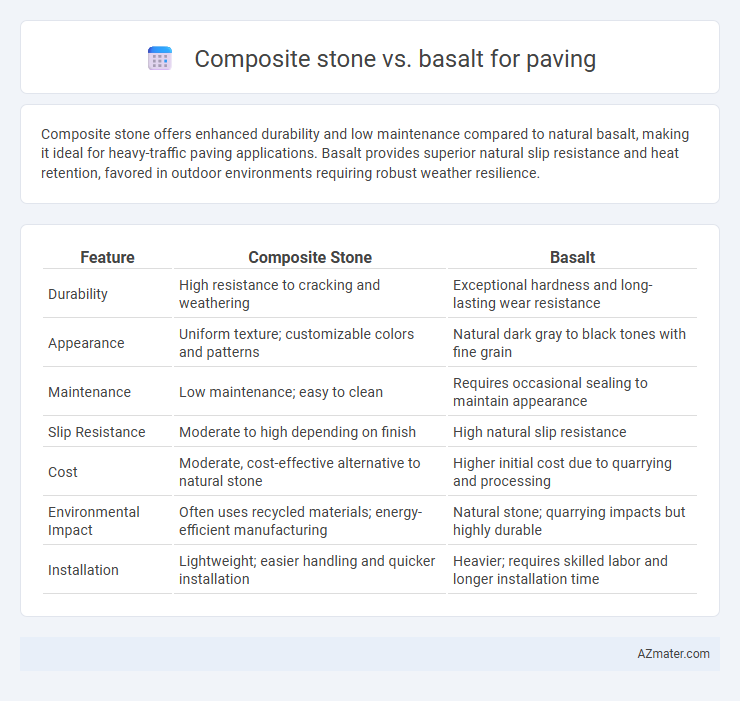Composite stone offers enhanced durability and low maintenance compared to natural basalt, making it ideal for heavy-traffic paving applications. Basalt provides superior natural slip resistance and heat retention, favored in outdoor environments requiring robust weather resilience.
Table of Comparison
| Feature | Composite Stone | Basalt |
|---|---|---|
| Durability | High resistance to cracking and weathering | Exceptional hardness and long-lasting wear resistance |
| Appearance | Uniform texture; customizable colors and patterns | Natural dark gray to black tones with fine grain |
| Maintenance | Low maintenance; easy to clean | Requires occasional sealing to maintain appearance |
| Slip Resistance | Moderate to high depending on finish | High natural slip resistance |
| Cost | Moderate, cost-effective alternative to natural stone | Higher initial cost due to quarrying and processing |
| Environmental Impact | Often uses recycled materials; energy-efficient manufacturing | Natural stone; quarrying impacts but highly durable |
| Installation | Lightweight; easier handling and quicker installation | Heavier; requires skilled labor and longer installation time |
Introduction to Composite Stone and Basalt
Composite stone consists of natural stone chips bound by resin, offering a versatile and durable surfacing option ideal for paving applications. Basalt is a volcanic rock known for its hardness, weather resistance, and slip-resistant properties, making it a popular natural choice for outdoor paving. Both materials deliver strong performance but differ significantly in composition, texture, and maintenance requirements.
Material Composition and Characteristics
Composite stone for paving combines natural stone aggregates with resin binders, offering enhanced durability, resistance to cracking, and a customizable appearance. Basalt, a dense volcanic igneous rock, features high compressive strength, excellent weather resistance, and a naturally rough texture ideal for non-slip surfaces. While composite stone provides versatility and uniformity, basalt excels in hardness and longevity, making it suitable for heavy-duty paving applications.
Durability and Strength Comparison
Composite stone offers superior impact resistance and flexibility, making it less prone to cracking under heavy loads compared to basalt. Basalt, a natural volcanic rock, exhibits high compressive strength and exceptional resistance to abrasion but can be more brittle and susceptible to chipping. For paving applications requiring longevity and toughness, composite stone provides enhanced durability with better resistance to weathering and freeze-thaw cycles than basalt.
Aesthetic Appeal and Design Options
Composite stone offers a wide range of colors, patterns, and textures that mimic natural materials while providing consistent quality and ease of customization for unique paving designs. Basalt, known for its deep, rich volcanic hues and durable surface, provides a natural, rugged aesthetic that enhances contemporary and rustic landscapes alike. Both materials offer distinct aesthetic appeal, with composite stone excelling in versatility and basalt standing out for its organic, timeless visual impact.
Installation Process and Ease
Composite stone offers a lighter weight and more uniform size compared to basalt, making installation faster and less labor-intensive for paving projects. Basalt's natural density and irregular shapes require careful handling and precise fitting, often extending installation time and complicating alignment. The composite stone's engineered consistency allows for simpler cutting and adjustment, improving overall ease and efficiency during the paving process.
Environmental Impact and Sustainability
Composite stone paving offers significant environmental benefits due to its use of recycled materials and lower energy consumption during manufacturing compared to basalt. Basalt, a natural volcanic rock, involves extensive quarrying that disrupts ecosystems and generates substantial carbon emissions. Choosing composite stone enhances sustainability by reducing resource extraction and minimizing landfill waste through material reuse.
Cost Analysis: Composite Stone vs Basalt
Composite stone offers a cost-effective alternative to basalt for paving, with initial installation expenses typically 20-40% lower due to less intensive quarrying and processing requirements. Basalt's durability and natural density contribute to higher upfront costs, but it may reduce long-term maintenance expenses thanks to its superior resistance to weathering and heavy traffic. Evaluating lifecycle costs, composite stone suits budget-sensitive projects while basalt provides robust investment value in high-traffic or demanding outdoor environments.
Maintenance Requirements and Longevity
Composite stone paving offers low maintenance requirements due to its resistance to stains, weathering, and fading, making it ideal for high-traffic areas with minimal upkeep. Basalt, a naturally durable volcanic rock, provides exceptional longevity and strength but may require periodic sealing and cleaning to prevent moss growth and surface erosion. Both materials balance durability with maintenance needs, though basalt's natural composition demands slightly more care to preserve its appearance over time.
Ideal Applications for Paving Projects
Composite stone offers lightweight durability and resistance to staining, making it ideal for residential patios and light commercial sidewalks where maintenance is a priority. Basalt's high density and natural slip resistance provide exceptional performance in heavy-traffic urban plazas and public walkways subjected to harsh weather conditions. The choice depends on load-bearing requirements and exposure, with composite stone preferred for aesthetic flexibility and basalt favored for long-term structural strength in paving projects.
Choosing the Right Material for Your Needs
Composite stone offers superior durability and low maintenance, making it ideal for high-traffic paving areas and outdoor spaces exposed to harsh weather. Basalt provides a natural aesthetic with excellent slip resistance and heat retention, perfect for decorative or climate-sensitive environments. Assess factors such as load-bearing requirements, environmental conditions, and design preferences to choose the right paving material tailored to your project's needs.

Infographic: Composite stone vs Basalt for Paving
 azmater.com
azmater.com